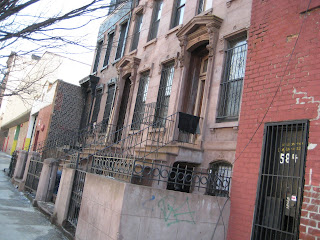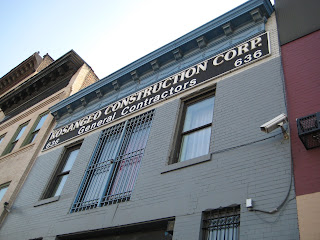The Downtown Brooklyn proposal prepared by the Department of City Planning and the New York Economic Development Corp stands out as problematic marketing material. Approved in 2004, it double-handedly convinced state and city officials to allow for massive changes to occur in Brooklyn while angering small business owners, residents and igniting a network of informal news/activity watchmen. To critically evaluate it in January 2009 is difficult for it appears to lack currency and substance.
Data for the Downtown Brooklyn plan stems from information based between the years 1990 and 2000. This period belongs to the dot-com era which was directly related to the internet and the advancement of internet based technology. The need for spaces wired and built with modern internet cabling may have led companies to seek locations outside of New York. However, while the Downtown Brooklyn Plan can be seen as providing startling figures regarding the loss of jobs to New Jersey (9,000 is the figure given) (slide 5), there is no statement about how many of these jobs still existed prior to the economic collapse of this past year which would have been a fair question to ask in 2004. In addition, the Plan’s figures in light of 2009, during a post-recession period is invalidated when unemployment across multiple sectors is rising. The most recent assessment can be found by the same commercial real estate services firm that was hired to provide statistical data for the Downtown Brooklyn Plan. In their 2008, Fourth Quarter issue of MarketBeat - Manhattan Office Report, Cushman & Wakefield write:
“New York’s commercial office market began to feel the full effects of the financial crisis in stages during 2008. Vacancy rates began to increase across the market during the first half of the year. As more financial firms came under pressure the amount of sublease space on the market rose sharply. By the end of 2008, sublease space on the market had increased by 4.7 million square feet or 132% and accounted for 25.8% of all available space…. Total available space, at 31.8 msf, grew by nearly 43% in the past year, driving the overall vacancy rate up 8% from 5.7%.
The increase in sublease availabilities began putting downward pressure on rents in mid-2008. By year-end, overall Manhattan asking rents had fallen $3.95 per square foot or about 5% from their peak. In Midtown, class A market rents in December were $6.99 psf below the August level.”*
To claim that a space is available for subleasing suggests that that it is “ready to be occupied in a short time frame” (slide 5), which is exactly what the NYDCP/NYCEDC stated as a goal in re-developing and re-zoning the downtown area. In addition, oddly enough, the amount of square footage now available due to the economic turmoil exceeds the targeted square footage of 4.5 million.
Another issue that makes the presentation slides highly visible as marketing material is the choice of words to describe the New Jersey construction: low-cost, inexpensive, ready-to-go. These terms do not suggest high quality, good design, and fail to evoke concepts of sustainable construction practices, terms that might help convince critics that the proposed permanent structures will be good for the community and last 100 years. With no architectural or environmental review of the processes that occurred in New Jersey or the quality of future development that may occur in Brooklyn to add, the Plan lacks authority.
One surprise discovery in reviewing the approved plan is that the nearby Atlantic Yards is technically not within the boundary lines of this re-zoned area. However, visual imagery of a partial city map suggests that Downtown Brooklyn is influenced and connected to eight different surrounding neighborhoods (annotated slides 5). Not many of these areas (if any at all) are connected to the Atlantic transit hub or can be reached on foot. Only a car or circulatory trolley/shuttle would feasibly connect these areas’ cultural resources, some of which are indicated with arrows out of the zone. But new connection techniques aside from sidewalks are not mentioned in the presentation.
While the varied urban environment is considered appealing and an existing asset to Brooklyn, the presentation slides also state that “building on the success of previous development efforts that have retained and attracted companies in NY, the plan would create new retail and housing and foster expanded academic and cultural facilities” (slide 1). The development that qualifies by city standards as “success” is not developed convincingly or backed visually to give viewers/readers proof of this statement. There are no images of existing conditions at street level that city planners consider successful or unsuccessful. In fact, what many critics consider successful pockets of the downtown areas are listed as blighted by city officials. Viewers are expected only to relate to a disconnected architectural street/block & lot map, which requires practice and mental associations to be made in order to understand. Indeed, the most recent large development may have been the MetroTech area. However, it is doubtful that MetroTech is the success which defines this part of Brooklyn as an appealing 24/7 community. Furthermore, simply the name of one promised academic institute would suffice as proof that the education sector is interested in the development and expansion. or whether certain steps would be taken by developers to cater their spaces for the provision of proper class rooms.
Another issue is the assumption that back-office workers, who are projected to be the new inhabitants of these office spaces, are going to want to engage in Brooklyn’s cultural venues that are relatively nearby. This thinking is incomplete in two ways: one is the assumption that they will engage in these forms of art/culture; and second is the assumption that workers will not simply flee/commute out of Brooklyn at the close of the work day as workers in Lower Manhattan do. Lower Manhattan suffers from its looming structures; the office buildings harbor no feeling of wanting to stay at the end of the day. It is doubtful that “a 5-foot sidewalk widening” is all that will be required to enhance the pedestrian experience (slide 22). My only engagement among these buildings is to cross them on the way to South Street Seaport, Bowling Green and the waterfront, or the transit hub around the World Trade Center. There is no guarantee that a 24/7 community will be created in the Downtown Brooklyn area with the addition of office towers, grounded with banks/chain stores that can be found elsewhere. The city’s own presentation can be used against them to reinforce this point: the Plan indicates that after the July 2001 approval of the “Special Downtown Brooklyn District”, which allowed for “more flexible height and setback controls and several upzonings,” there was an increase in the “construction of new apartment houses” (slide 2). The statement is problematic because “apartment houses” signify small sized, less invasive construction and because developers are tending toward the construction of condominiums, in lieu of office space against the goals established in the Plan.
Finally, another poor marketing tool included in the presentation is the use of Rockefeller Center to create a visual suggestion of what a new center would be like. The only commonality between the two is that the Downtown Brooklyn Plan is as speculative in the current economic crisis as Rockefeller Center’s construction was seen during the Great Depression. RockefellerCenter’s situation in Manhattan is entirely different from Downtown Brooklyn. The center caters to tourists who can afford to go to the theaters, go to overpriced restaurants, museums, and do not need grocery stores or mom-and-pop hardware stores. In its entirety, Brooklyn is considered a residential “city”, juxtaposed against the working city that Manhattan is. To ignore its past history and viable usage may cause existing residents or critics of the plan to feel frustrated. More importantly, Rockefeller Center is near both official and unofficial landmark, including St. Peter’s Cathedral, Saks Fifth Avenue, Radio City, Times Square and the jewelry district. To build upon the handful of landmarks with the addition of more to this area is one technique overlooked by the plan and city starting from the neglect and subsequent demolition of the old Atlantic Terminal.
Bibliography
*Cushman & Wakefield 4th Quarter Report 2008
NYC Department of City Planning - Downtown Brooklyn Plan (Full)
http://www.nyc.gov/html/dcp/html/dwnbklyn2/dwnbklynintro1.shtml
NYC Department of City Planning - Downtown Brooklyn Plan (Annotated)
http://www.nyc.gov/html/dcp/pdf/dwnbklyn2/dwnbklyn.pdf








 (a)
(a) (b)
(b) (c)
(c) (d) <-link
(d) <-link (e)
(e) (f)
(f) (g)
(g) (h)
(h)


